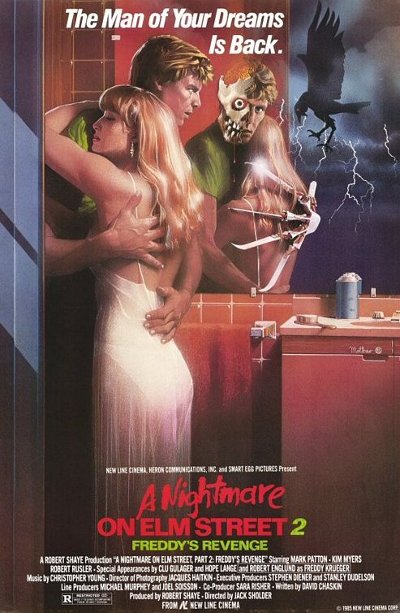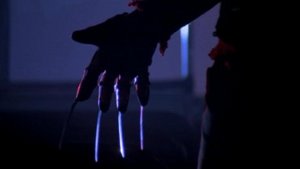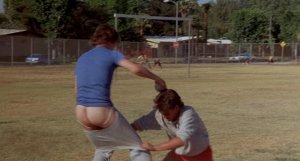
After the success of A Nightmare on Elm Street in November 1984, it seemed inevitable that a sequel would soon follow. The final moments of the first movie had been manufactured by the producer in an effort to allow for further instalments, and with approximately $10m made in the first two months of its theatrical run a sequel was rushed into production, making its debut exactly one year later. Freddy had yet to become a symbol of pop culture and the concept of music videos and television shows were far off into the future. With only Robert Englund returning from the previous film, it was decided that a new story with new characters would be the best course of action. This time, instead of Freddy terrorising the protagonist in his dreams he would try to possess his body, a plot point which would anger many of the hardcore fans.
 A school bus heads through a quiet neighbourhood, picking up kids on its way. One of the students is Jesse Walsh (Mark Patton), a shy and creepy teenager who shifts uncomfortably in his seat as he tries to open the window. The bus starts to speed up and eventually Jesse and two girls sat at the back (JoAnn Willette and Allison Barron) grow concerned. Suddenly they drive off the road and into the desert, the driver laughing maniacally as he slams his foot down on the accelerator. Eventually they come to a halt and the ground around them starts to crumble, until they are trapped on a small island with the bus rocking back and forth. The driver stands up to reveal Freddy, who drags his claws across the roof as he closes in on them. But as he pounces, Jesse suddenly wakes up in his bed screaming. ‘Why can’t Jesse wake up like everybody else?’ asks his sister (Christie Clark) to her parents (Clu Gulager, Hope Lange).
A school bus heads through a quiet neighbourhood, picking up kids on its way. One of the students is Jesse Walsh (Mark Patton), a shy and creepy teenager who shifts uncomfortably in his seat as he tries to open the window. The bus starts to speed up and eventually Jesse and two girls sat at the back (JoAnn Willette and Allison Barron) grow concerned. Suddenly they drive off the road and into the desert, the driver laughing maniacally as he slams his foot down on the accelerator. Eventually they come to a halt and the ground around them starts to crumble, until they are trapped on a small island with the bus rocking back and forth. The driver stands up to reveal Freddy, who drags his claws across the roof as he closes in on them. But as he pounces, Jesse suddenly wakes up in his bed screaming. ‘Why can’t Jesse wake up like everybody else?’ asks his sister (Christie Clark) to her parents (Clu Gulager, Hope Lange).
The Walsh family are new to the town and have moved into 1428 Elm Street, where five years earlier Nancy Thompson had been terrorised by the demonic Krueger and had seen all of her friends brutally slain. Now Jesse is suffering from his own nightmares, where Freddy comes to him and tries to scare him into giving up his body so that he can escape the dream world and stalk the living. Jesse’s only friend is Lisa Webber (Kim Myers), a quiet girl from the rich neighbourhood who has taken a shine to the disturbed young man. During a football game he locks horns with Ron Grady (Robert Rusler), who first comes across as a jock but when the two are forced to do push ups for fighting by their cruel coach (Marshall Bell) they soon discover that they get along. But when Grady tells him about the history of his house, Jesse confronts his father as to how they managed to purchase the home so cheap.
 As he packs away his clothes Lisa discovers an old diary at the back of the wardrobe which had belonged to Nancy. Jesse immediately recalls Grady’s story, as well as his own nightmares. Lisa continues to read and eventually does some research on the story of Fred Krueger, which revealed how he had taken his young victims to the boiler room where he had worked and kill them. But Krueger’s hold over Jesse grows stronger, resulting in several brutal murders which all lead back to Jesse. Even as Lisa tries to give him a normal life by inviting him to her pool party and seducing him, the evil inside of him begins to fight back and it’s only a matter of time until one of them loses. Lisa discovers by reading the diary that it is the screams of the victims that give Freddy his power and that only by showing strength and denying him his fear can he stop him.
As he packs away his clothes Lisa discovers an old diary at the back of the wardrobe which had belonged to Nancy. Jesse immediately recalls Grady’s story, as well as his own nightmares. Lisa continues to read and eventually does some research on the story of Fred Krueger, which revealed how he had taken his young victims to the boiler room where he had worked and kill them. But Krueger’s hold over Jesse grows stronger, resulting in several brutal murders which all lead back to Jesse. Even as Lisa tries to give him a normal life by inviting him to her pool party and seducing him, the evil inside of him begins to fight back and it’s only a matter of time until one of them loses. Lisa discovers by reading the diary that it is the screams of the victims that give Freddy his power and that only by showing strength and denying him his fear can he stop him.
For various reasons, Freddy’s Revenge is the most misunderstood and despised of the franchise. Many fans felt that it broke the rules of the first film (despite the two sequels which creator Wes Craven would be involved with would break them even further) by allowing him to possess his victims instead of just killing them. A popular analysis amongst critics is that the movie is homophobic in its murder of the gay coach and that it is the love of a woman which eventually saves him. Whilst there are a few elements which seem a little camp (during the fight between Grady and Jesse the latter’s pants are pulled down to reveal his buttocks, he is caught dancing in his room to Touch Me (All Night Long) whilst performing a masturbation-style guitar strum on a tennis racket, and the major give-away, a ‘No Chicks’ sign on his bedroom door), the central theme of the movie is not homosexuality and there is no evidence to prove that the killing of the coach was sexually motivated.
 But for its shortcomings, there are several elements which make Freddy’s Revenge truly effective. The combination of Englund’s sneering performance and the makeup by Kevin Yagher make Krueger a very menacing presence, whilst Yagher’s groundbreaking effects (particularly during the scene when Freddy cuts his way out of Jesse’s body) are amongst the best of the series. The cinematography (by Jacques Haitkin and Christopher Tufty) is very impressive and creepy, as is the score by Christopher Young, who would later find acclaim with Hellraiser. Perhaps the film’s most effective set piece is the opening sequence with the school bus, an image which terrorised a generation of children. Whilst Freddy’s Revenge may not be to everyone’s taste, it is certainly an improvement on the later sequels, particularly the fourth and sixth, and thankfully lacks the one-liners and constant pop culture references which would eventually kill the series.
But for its shortcomings, there are several elements which make Freddy’s Revenge truly effective. The combination of Englund’s sneering performance and the makeup by Kevin Yagher make Krueger a very menacing presence, whilst Yagher’s groundbreaking effects (particularly during the scene when Freddy cuts his way out of Jesse’s body) are amongst the best of the series. The cinematography (by Jacques Haitkin and Christopher Tufty) is very impressive and creepy, as is the score by Christopher Young, who would later find acclaim with Hellraiser. Perhaps the film’s most effective set piece is the opening sequence with the school bus, an image which terrorised a generation of children. Whilst Freddy’s Revenge may not be to everyone’s taste, it is certainly an improvement on the later sequels, particularly the fourth and sixth, and thankfully lacks the one-liners and constant pop culture references which would eventually kill the series.

13 Responses to A Nightmare on Elm Street Part 2: Freddy’s Revenge (1985) Review